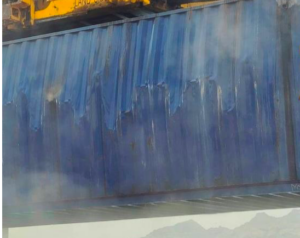The Charity
Aviation
Maritime
M2253

Initial Report
Smoke and a burning smell were detected during port operations. One container stowed in the hold was found emitting smoke, and the side wall of the container was bulging due to the heat and pressure. The container was discharged promptly and moved to the terminal container yard.
CHIRP Comment
Fortunately, an observant crew member or stevedore saw the signs of fire early before other containers were loaded on top.
Charcoal, categorised as UN1361 and falling under Class 4.2, presents unique risks due to its tendency to spontaneously ignite if stored improperly. Essentially, when exposed to oxygen, charcoal oxidises, generating heat. To ensure accurate understanding, shippers must precisely label the cargo as carbon/charcoal, as it goes by other names, and its hazardous nature may not be apparent otherwise.
The IMDG Code includes a special provision (SP 925) allowing exemption from Class 4.2 classification under specific conditions, permitting bulk shipment of charcoal. Accredited authorities must conduct and document tests and issue certificates to confirm compliance before transportation is permitted.
Storing warm or hot charcoal accelerates oxidation, leading to dangerous heat build-up that standard cooling methods may not counteract. This self-heating process can escalate to ignition, posing significant risks. The duration for self-heating varies by charcoal type and weathering and is typically around two weeks before loading into a container.
To address the challenge of charcoal fires, CHIRP advises storing containers on deck for easier access, facilitating swift containment and safe discharge in port, thereby reducing hazards.
The Cargo Incident Notification System (CINS) and the International Group of P&I Clubs offer valuable guidance on the stowage and handling guidelines, jointly published in their 2017 document ‘Guidelines for the Carriage of Charcoal and Carbon in Containers’.
Key Issues relating to this report
Pressure- Did undue pressure allow the charcoal container to be shipped without the proper procedures? Have you examined how your charcoal is processed before being shipped on board?
Local practices—This is a high-risk cargo, where there is always a risk of fire. Never cut corners. Ensure that proper documentation is provided and be alert to local norms at different ports.
Capability—Do your office and ship’s staff have the necessary training to appreciate the IMDG code fully? Does your regular shipper have proper processes to ensure the charcoal is safe to carry? Do you regularly check the temperatures of containers loaded with charcoal? Does your ship have an infrared heat gun?
Design- is your ship fitted with the necessary firefighting equipment to handle a fire in charcoal stowed on deck?







